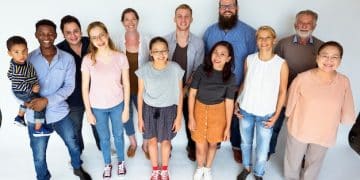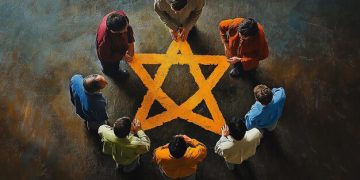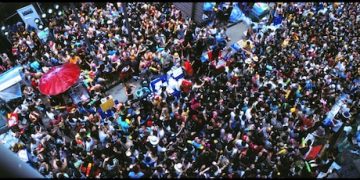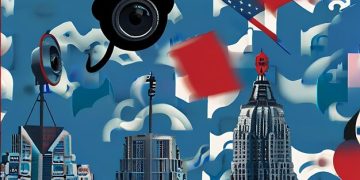US Cultural Identity Trends: Impact on Social Cohesion
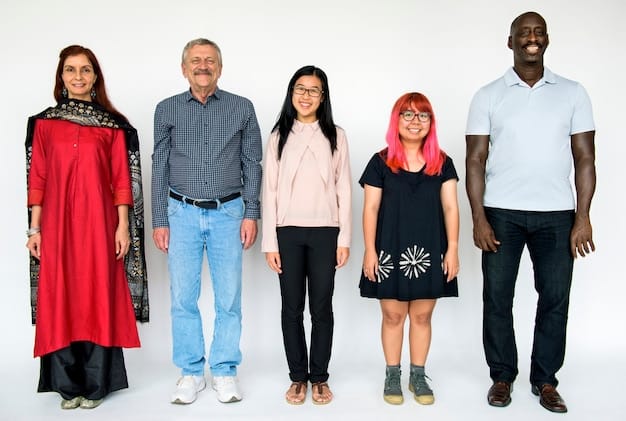
The latest trends in US cultural identity, including increasing diversity, digital identity formation, and political polarization, significantly impact social cohesion by creating both opportunities for enriched understanding and challenges in maintaining unity.
What are the latest trends in US cultural identity and how do they affect social cohesion? This question lies at the heart of understanding the shifting dynamics within American society today. As the US becomes increasingly diverse and interconnected, cultural identity is being reshaped in profound ways, influencing everything from political discourse to everyday interactions.
The Rise of Intersectional Identities
One of the most significant trends in the US cultural landscape is the rise of intersectional identities. This concept acknowledges that individuals possess multiple, overlapping identities based on factors such as race, gender, class, sexual orientation, and more.
Understanding how these identities interact is crucial for fostering social cohesion in an increasingly diverse society.
Understanding Multiple Identities
Intersectionality highlights that individuals cannot be understood by a single identity marker. For example, a Black woman’s experience cannot be fully understood by only considering her race or her gender in isolation. Instead, her experiences are shaped by the intersection of both.
Impact on Social Justice Movements
Intersectional awareness has reshaped social justice movements, promoting inclusivity and addressing the needs of marginalized groups more effectively. Movements now recognize the importance of addressing multiple forms of discrimination simultaneously.
- Increased awareness of systemic inequalities.
- More inclusive representation in media and politics.
- Greater emphasis on addressing intersectional discrimination in policy.
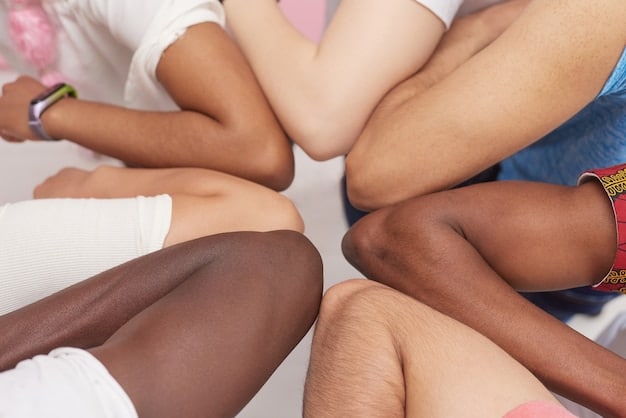
Intersectional identities play a crucial role in our everyday experiences. They affect our interactions, our perspectives, and our understanding of the world around us. By recognizing and celebrating these complexities, we can create a more inclusive and equitable society.
Digital Identity and Online Communities
The internet has become a primary space for identity formation, particularly among younger generations. Digital platforms offer opportunities to explore, express, and connect with others who share similar interests and values. This trend has significant implications for social cohesion, both positive and negative.
Online communities can foster a sense of belonging and shared identity, but they can also contribute to polarization and the spread of misinformation.
The Role of Social Media
Social media platforms provide spaces for individuals to curate their online identities, often highlighting aspects of their lives and beliefs that resonate with specific audiences. This can lead to the formation of echo chambers where individuals are primarily exposed to reinforcing viewpoints.
Online Activism and Social Change
Digital platforms have become powerful tools for activism and social change, enabling marginalized groups to organize, mobilize, and advocate for their rights. However, online activism also faces challenges, including censorship, surveillance, and the spread of disinformation.
- Increased engagement in online social movements.
- Greater visibility for marginalized voices.
- Challenges in combating online harassment and hate speech.
Digital environments create both opportunities and challenges for fostering social cohesion. While online communities can connect people across geographical boundaries, they also have the potential to reinforce existing divisions. Critical thinking and media literacy are essential skills for navigating the digital landscape constructively.
Political Polarization and Cultural Divide
Political polarization has become a defining feature of contemporary US society, with deep divisions emerging along ideological lines. These divisions often extend into cultural identities, shaping how people perceive themselves and others.
Understanding the roots and consequences of political polarization is essential for bridging cultural divides and promoting social cohesion.
The Impact of Media Fragmentation
The proliferation of partisan media outlets has contributed to the reinforcement of political ideologies, creating distinct information ecosystems where individuals are exposed to selectively curated news and perspectives. This media fragmentation can exacerbate existing cultural divides and make it more difficult to find common ground.
Political Identity as Cultural Identity
For many Americans, political affiliation has become a core component of their cultural identity, influencing their social circles, consumer choices, and even personal relationships. This trend has led to increased animosity and distrust between people with different political beliefs.
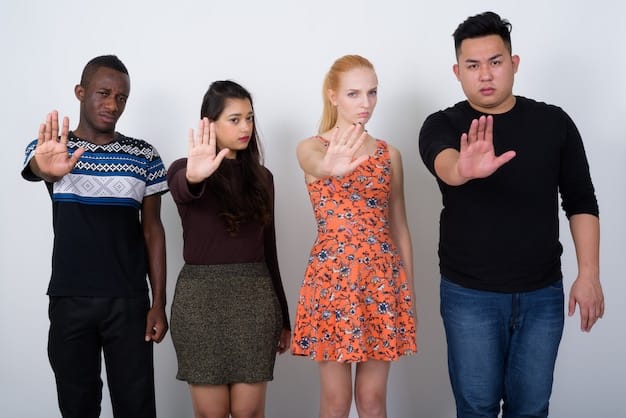
Political polarization significantly affects social cohesion by creating echo chambers and reinforcing ideological divisions. Strategies for bridging these divides involve promoting dialogue, encouraging empathy, and fostering a shared sense of national identity.
Demographic Shifts and Cultural Adaptation
The US is experiencing significant demographic shifts, with increasing racial and ethnic diversity. These changes are reshaping the cultural landscape, leading to both opportunities for cultural enrichment and challenges in adapting to new social dynamics.
Understanding how demographic shifts influence cultural identity and social cohesion is crucial for building inclusive and equitable communities.
The Growth of Multiculturalism
Multiculturalism is on the rise in the US, with more people embracing and celebrating their diverse cultural backgrounds. This trend has led to greater cultural awareness and appreciation, as well as increased demand for representation and inclusion in various sectors of society.
Challenges of Integration
While multiculturalism offers numerous benefits, it also presents challenges in integrating diverse groups into the mainstream. These challenges can include language barriers, cultural misunderstandings, and unequal access to resources and opportunities.
- Increased cultural exchange and understanding.
- Greater diversity in media and arts.
- Challenges in addressing cultural biases and prejudices.
Demographic shifts significantly impact cultural identity and social cohesion by introducing new perspectives and experiences. Strategies for navigating these changes effectively include promoting intercultural dialogue, investing in language education, and addressing systemic inequalities that prevent full integration.
Generational Differences in Cultural Values
Different generations hold distinct cultural values and perspectives, shaped by the historical events, social trends, and technological advancements that have defined their formative years. These generational differences can influence everything from work ethics to political beliefs.
Understanding how generational values impact cultural identity and social cohesion is crucial for bridging intergenerational gaps and fostering collaborative relationships.
The Influence of Technology
Technology has had a profound impact on generational values, with younger generations growing up in a digital world and older generations adapting to new technologies at different paces. This can lead to different communication styles, information consumption habits, and expectations for social interaction.
Shifting Priorities
Generational differences are also evident in shifting priorities, such as work-life balance, environmental sustainability, and social justice. Younger generations are often more focused on these issues than older generations, leading to potential conflicts and misunderstandings.
Generational differences play a vital role in shaping cultural identity and social cohesion by introducing diverse perspectives and values. Strategies for bridging these gaps involve facilitating intergenerational dialogue, recognizing the strengths of each generation, and promoting mutual respect and understanding.
The Role of Education in Shaping Cultural Identity
Education plays a crucial role in shaping cultural identity by transmitting knowledge, values, and beliefs from one generation to the next. Educational institutions can promote social cohesion by fostering critical thinking, cultural awareness, and a sense of shared citizenship.
However, education can also perpetuate inequalities and reinforce existing cultural biases if not approached with intentionality and inclusivity.
Curriculum Development
The content of educational curricula is a significant factor in shaping cultural identity. Inclusive and representative curricula can promote understanding and appreciation of diverse cultures, while biased or incomplete curricula can reinforce stereotypes and marginalize certain groups.
Promoting Critical Thinking
Education can also play a role in developing critical thinking skills, enabling students to evaluate information objectively and challenge prevailing narratives. This is particularly important in a polarized society where misinformation and propaganda are rampant.
- Promoting diverse perspectives in the classroom.
- Encouraging critical analysis of cultural norms and values.
- Fostering a sense of shared citizenship and civic responsibility.
Education significantly impacts cultural identity and social cohesion by shaping values, beliefs, and attitudes. Strategies for leveraging education to promote unity involve developing inclusive curricula, fostering critical thinking skills, and creating opportunities for intercultural dialogue and collaboration.
| Key Point | Brief Description |
|---|---|
| 🤝 Intersectionality | Overlapping identities shape individual experiences. |
| 📱 Digital Identity | Online platforms impact identity formation. |
| 🇺🇸 Political Polarization | Divisions affect cultural identities. |
| 🌍 Demographic Shifts | Diversity reshapes cultural understanding. |
Frequently Asked Questions
▼
Intersectionality recognizes that individuals have multiple, overlapping identities, such as race, gender, and class, which together shape their unique experiences and perspectives in society.
▼
Digital platforms offer spaces for individuals to explore, express, and connect with others, influencing identity formation. However, these platforms can also contribute to echo chambers and the spread of misinformation.
▼
Political polarization creates deep divisions along ideological lines, often extending into cultural identities, leading to increased animosity and distrust between people with different political beliefs.
▼
Challenges include language barriers, cultural misunderstandings, and unequal access to resources and opportunities, all of which can hinder the full integration of diverse groups into the mainstream.
▼
Education can promote social cohesion by fostering critical thinking, cultural awareness, and a sense of shared citizenship through inclusive curricula and opportunities for intercultural dialogue.
Conclusion
In conclusion, the evolving trends in US cultural identity significantly impact social cohesion. Intersectionality, digital identity, political polarization, demographic shifts, generational differences, and education all play vital roles in shaping the cultural landscape. By understanding these dynamics, we can work towards building a more inclusive and unified society.
